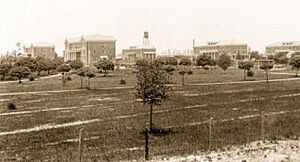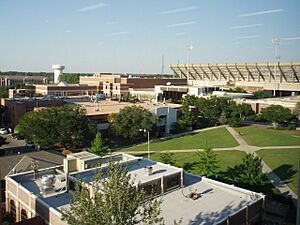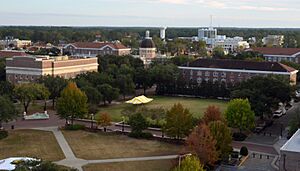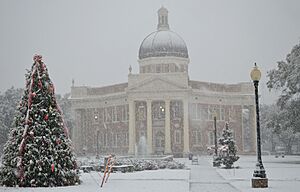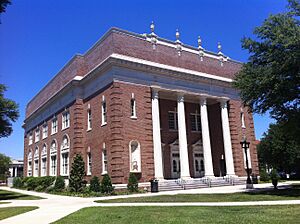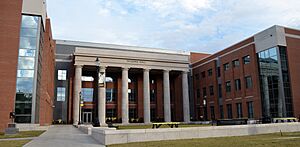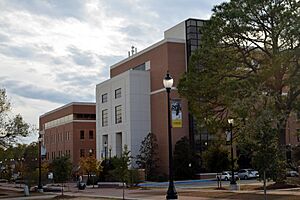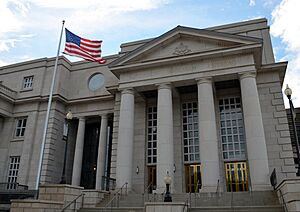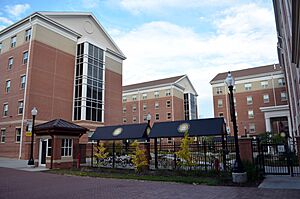University of Southern Mississippi facts for kids
The University of Southern Mississippi (often called Southern Miss or USM) is a public university with its main campus in Hattiesburg, Mississippi. It's a place where students can earn many different types of college degrees, from bachelor's to doctorates. USM is known for its strong research programs.
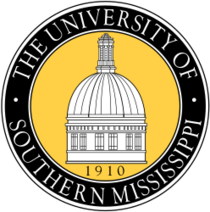 |
|
|
Former names
|
Mississippi Normal College (1910–1924) State Teachers College (1924–1936) Mississippi State Teachers College (1936–1940) Mississippi Southern College (1940–1962) |
|---|---|
| Motto | "Southern Miss to the Top!" |
| Type | Public research university |
| Established | March 30, 1910 |
|
Parent institution
|
Mississippi Institutions of Higher Learning |
| Accreditation | SACS |
|
Academic affiliation
|
|
| Endowment | 3.5 million (2020) |
| President | Joseph S. Paul |
| Provost | Lance Nail |
|
Academic staff
|
899 (Fall 2017) |
| Students | 14,606 (Fall 2020) |
| Undergraduates | 11,451 |
| Postgraduates | 3,155 |
| Location |
,
,
United States
31°19′47″N 89°20′02″W / 31.329638°N 89.333847°W |
| Campus | Small city, 300 acres (1.2 km2) |
| Other campuses | |
| Media | Student Media Center |
| Colors | Black and gold |
| Nickname |
|
|
Sporting affiliations
|
|
| Mascot | Seymour d'Campus |
 |
|
The university was started on March 30, 1910. It has two main campuses: one in Hattiesburg and another called Gulf Park in Long Beach. There are also five other places where students can learn and do research, including the John C. Stennis Space Center.
Southern Miss sports teams were first called the Mississippi Southerners. In 1972, they became the Golden Eagles. The school's colors, black and gold, were chosen by students soon after the university opened. These colors have stayed the same, even as mascots and names have changed. USM has 17 sports teams that compete in NCAA Division I athletics, mostly in the Sun Belt Conference.
Contents
History of Southern Miss
The University of Southern Mississippi began on March 30, 1910. It was first called Mississippi Normal College. This school was created to train teachers. Before this, teachers had to travel a lot to get ready for their jobs.
The first buildings were designed by R. H. Hunt. The college's first president, Joseph Anderson Cook, welcomed the first students on September 18, 1912. He oversaw the building of College Hall, Forrest County Hall, Hattiesburg Hall, the Industrial Cottage, and the president's home. In its first year, Mississippi Normal College had 876 students.
As the school grew and added more subjects, its name changed. In 1924, it became Mississippi State Teachers College. Then, in 1940, it was renamed Mississippi Southern College.
The fifth president, William David McCain, started in 1955. He helped the college grow a lot. He oversaw the building of 17 new buildings. He also convinced the governor to make the school a university because it had so many graduate programs. On February 27, 1962, the school officially became the University of Southern Mississippi.
Working Towards Equality
In 1954, the U.S. Supreme Court said that separating public schools by race was against the law. However, when Clyde Kennard, a Black veteran, tried to enroll at Mississippi Southern College in the late 1950s, he was stopped. He tried three times but was not allowed to join. Kennard spoke out about equal education. He was later honored for his efforts to open doors for all students. In 2018, USM placed a special marker to remember Clyde Kennard. He also received an honorary degree from USM after his death.
By the mid-1960s, there was more pressure to integrate colleges in Mississippi. Other universities in the state had already started to allow Black students. USM leaders made plans to welcome their first Black students. They wanted to make sure the process was peaceful.
In September 1965, two Black students, Gwendolyn Elaine Armstrong and Raylawni Branch, enrolled without any problems. This was a big step forward for the university.
In 1969, the Afro-American Cultural Society (AACS) was started. This group was important for Black students at the university. It later changed its name to the African American Student Organization (AASO).
The late 1960s and early 1970s brought many changes. The university worked to hire more Black teachers. In 1972, the school changed its mascot from "General Nat" to the Golden Eagles. In 1974, Fred Cook became the first Black "Mr. USM." The first Black Greek organizations started in 1975. By 1975, the university had grown to 11,000 students.
After these changes, the University of Southern Mississippi kept growing. Some big changes included switching from a "quarter" system to a "semester" system for classes. They also created new science programs, reorganized their colleges, and started offering online classes. The Gulf Coast campus also expanded.
University Presidents
- Joseph Anderson "Joe" Cook – 1912–1928
- Claude Bennett – 1928–1933
- Jennings Burton George – 1933–1945
- Robert Cecil Cook – 1945–1954
- Richard Aubrey McLemore (acting president) – 1955
- William David McCain – 1955–1975
- Aubrey K. Lucas – 1975–1996
- Horace Weldon Fleming Jr. – 1997–2001
- Aubrey Keith Lucas (interim president) – 2001–2002
- Shelby Freeland Thames – 2002–2007
- Martha Dunagin Saunders – 2007–2012
- Aubrey Keith Lucas (interim president) – 2012–2013
- Rodney D. Bennett – 2013–2022
- Joseph S. Paul – 2022–present
Recent University Growth
| USNWR National University | 352 |
|---|---|
| Washington Monthly National University | 235 |
| Forbes | 522 |
In the early 2000s, under President Shelby Thames, Southern Miss saw a big increase in research. The university was recognized for its very high research activity. In 2018, USM spent $61 million on research and development.
President Thames was praised for his work after Hurricane Katrina in 2005. The storm caused over $100 million in damage to the Gulf Park campus. But Thames made sure no university employees lost their jobs.
His time as president also saw many new buildings on campus. These included a large Barnes & Noble bookstore and new dining areas. There were also new sports facilities and improvements to make the campus more friendly for walking.
The university's rankings in U.S. News & World Report changed during this time. After some challenges, the university improved its ranking. In 2016, USM was ranked 125th among national public universities.
Washington Monthly also ranks universities. They look at how much good a university does for the country. In 2018, USM was ranked 235th among national universities by Washington Monthly. This was the highest ranking for any school in Mississippi.
On February 10, 2013, a strong tornado hit the Southern Miss campus. It caused millions of dollars in damage. Two buildings were destroyed, and six others were damaged. Luckily, most students were away for a holiday, and there were warnings. So, no one died, and only a few people were hurt on campus.
In 2015, Southern Miss decided to remove the Mississippi state flag from its campuses. The university president, Rodney D. Bennett, said the university would only fly flags that brought all students together.
Golden Eagle Logo Change
In 2003, Southern Miss changed its eagle logo. Two years later, the University of Iowa said the new logo looked too much like their Hawkeyes logo. This caused a disagreement. In 2011, the U.S. Patent and Trademark Office said Southern Miss could not trademark the new logo. In 2014, Southern Miss created a new, redesigned logo that was different enough to be copyrighted.
Army ROTC Program
In 2013, the U.S. Army announced it might close 13 ROTC programs, including the one at Southern Miss. This was due to money issues and a low number of officers being trained. Many people, including the Governor of Mississippi, protested this decision. The Army later changed its plan. The USM ROTC program was put on a two-year trial period but is now off probation and continues to operate.
University Campuses
Gulf Park Campus
The university started offering classes on the Mississippi Gulf Coast in 1947. Over the years, these classes moved to different locations. In 1964, they moved to Keesler Air Force Base.
In 1972, the University of Southern Mississippi bought the Gulf Park College for Women campus in Long Beach. This became the main Gulf Coast campus. A famous landmark there is the Friendship Oak. This huge oak tree is about 1487 years old! It has survived many hurricanes, including Hurricane Katrina.
In 2002, the Gulf Park Campus started accepting freshmen students. This made USM the only university in Mississippi with two main campuses.
The Gulf Park campus also manages several other teaching and research sites:
- The Stennis Space Center is a NASA rocket engine test facility. It's also home to USM's Department of Marine Science.
- The Gulf Coast Research Laboratory (GCRL) in Ocean Springs focuses on coastal sciences.
- The Keesler Center on Keesler Air Force Base offers classes for military members and others.
On August 29, 2005, Hurricane Katrina caused about $115 million in damage to Gulf Park. Classes had to move to a different location for a while. In 2012, all facilities moved back to the renovated Long Beach campus.
University Libraries
- The Cook Library is on the Hattiesburg campus. It holds most of the books, magazines, and other materials that help students with their studies.
- The McCain Library and Archives is also in Hattiesburg. It has special collections, like the de Grummond Children's Literature Collection. This collection has many old and rare children's books.
- The Gulf Coast Library is on the Long Beach campus. It's a modern library that serves students on the Gulf Coast.
- The Gunter Library is at the Gulf Coast Research Laboratory in Ocean Springs. It has scientific information for researchers and students.
Campus Landmarks
- The District is a historic part of the Hattiesburg campus. It has the five original university buildings. It's also a popular spot for students to gather before football games. Lake Byron is here, too.
- The Century Gate is a brick and stone wall at the front of the university. It was built to celebrate the university's 100th birthday in 2010.
- The All-American Rose Garden is one of only two such gardens in Mississippi. It has many different types of roses. It's against school rules to pick a rose from the garden, and if you get caught, there's a $500 fine!
- The Eagle Walk is under the football stadium. Before football games, the marching band and football players walk through here to cheering fans. New students help repaint the walls each fall.
- The Dome is the nickname for the Lucas Administration building. It has a large dome on its roof. It used to be copper-colored, then turned green, and was repainted copper in 2001. It holds the offices of the university president.
- Shoemaker Square has a brick fountain. Students often gather here for pep rallies before football games. Sometimes, pranksters put soap in the fountain!
- The Little Rock is in the historic district. Students paint it weekly to advertise events like sports games or art shows.
- The Eagle Statue, also called "Lofty Return," is a huge, three-ton sculpture of a Golden Eagle. It's 22 feet tall and stands near Hardy Street. A smaller copy is on the Gulf Park campus.
Academics at Southern Miss
Southern Miss offers about 189 different programs for degrees. Most students come from Mississippi, but many also come from other Southern states and around the world. The university's programs are approved by many state and national groups.
The University of Southern Mississippi has over 250 clubs and organizations. These include student government, the student newspaper (The Student Printz), and various Greek organizations. Students can also join intramural sports.
The university hosts more than 300 cultural events each year. These include a Jazz and Blues Festival, performances by the theater and music departments, and art exhibits. The Dale Center for the Study of War and Society brings famous speakers to campus, like General David Petraeus and former Secretary of State Madeleine Albright.
The University of Southern Mississippi is led by the University President and the Mississippi Board of Trustees. The President manages the university day-to-day.
Colleges and Schools
The University of Southern Mississippi recently changed how its academic programs are organized. It now has four main colleges:
|
|
USM also offers other special programs:
- George R. Olliphant Honors College
- Graduate Studies
- International Studies Program
- Online programs in Sport Management and Sport Coaching Education
- DuBard School for Language Disorders (helps children with language difficulties)
- Frances A. Karnes Center for Gifted Studies (for gifted students)
Student Life
| Race and ethnicity | Total | ||
|---|---|---|---|
| White | 60% |
|
|
| Black | 29% |
|
|
| Hispanic | 4% |
|
|
| Other | 3% |
|
|
| Asian | 1% |
|
|
| Foreign national | 1% |
|
|
| Economic diversity | |||
| Low-income | 50% |
|
|
| Affluent | 50% |
|
|
The school year at USM runs from August to December and January to May. There are also summer classes.
In 2006, Southern Miss opened a new, large addition to its student union. This building, called the Thad Cochran Center, has a two-story Barnes & Noble bookstore, ballrooms, a theater, and student offices. It also has dining options.
In 2010, the university opened Century Park North, a new living area with four dorms. In 2014, Century Park South opened with three more dorms and a student health center.
USM has almost 300 student organizations for many different interests. Some of the largest groups include the Student Government Association and the African-American Student Organization.
Greek Life
The university has 26 Greek organizations, including fraternities and sororities. There are 19 houses for these groups on campus.
Dining Services
Aramark provides dining services at USM, known as Eagle Dining. They run several places to eat on campus:
- The Fresh Food Company: A buffet-style cafeteria in the Thad Cochran Center.
- The Agora: A food court with Bento Sushi and Einstein Bros. Bagels.
- Seymour's: A food court with Subway and Chick-Fil-A.
- Freshens: Located in Asbury Hall.
- Southern Wing Company: A restaurant near Cook Library.
- The Grub Slinger: A food truck that moves around campus.
- Starbucks: Located in Cook Library.
Eagle Dining also has small convenience stores called Provisions on Demand (POD) in several buildings.
Student Housing
The University of Southern Mississippi has 13 dorms. About 5,000 students live on campus during the school year.
Publications and Media
- Southern Miss Now is the official news source for the university.
- The Student Printz is the student-run newspaper, published weekly.
- The Southerner was the university's yearbook, but it stopped being published in 2015.
- WUSM FM 88.5 is the university's public radio station.
- Mississippi Review is a journal that publishes stories, poems, and essays. It was one of the first literary magazines to have a full online version.
- The Drawl is a publication about Southern Miss traditions and history, given to new students.
- The Talon is a magazine for university alumni and friends.
- Gulf and Caribbean Research is a science journal about marine life and oceans in the Gulf of Mexico and Caribbean Sea.
Mardi Gras Holiday
The University of Southern Mississippi is one of the few universities in Mississippi that has a two-day holiday for Mardi Gras. Classes are canceled on the Monday and Tuesday before Ash Wednesday.
Students wanted this holiday because the university is close to New Orleans, where Mardi Gras is a big celebration. In 1981, a student leader asked for the holiday. After some discussion, the university president agreed to try it in 1982. By 1984, the Mardi Gras holiday became a permanent part of the university calendar. In 2003, students successfully asked for the Monday before Mardi Gras to be a holiday too, creating a four-day weekend. Many students use this time to prepare for exams or visit family.
Athletics
The Golden Eagles have done very well in sports. Southern Miss has won national titles in football twice and in track and field three times. In 2011, the football team was ranked No. 19 in the country. The football team has also played in 24 bowl games, winning 12 of them. In 1982, the Golden Eagle football team famously beat Alabama's Crimson Tide in their coach Bear Bryant's last home game. M.M. Roberts Stadium is the home of the football team and can hold 36,000 fans.
The Golden Eagle baseball team has won the Conference USA championship twice. They have also been invited to 12 NCAA regional tournaments and even made it to the College World Series once. The baseball team's new players are ranked No. 3 in the country by Baseball America. The Southern Miss basketball team has won the NIT tournament once.
Fine Arts
The University of Southern Mississippi is special because it's one of only a few universities in America that is recognized for excellence in all four main fine arts areas: art, dance, theater, and music.
The university has a Wind Ensemble and a Symphony Orchestra. Famous musicians like Ray Charles and Yo-Yo Ma have performed with the orchestra. The Southern Chorale (a choir) has performed at Carnegie Hall in New York City and in other countries.
The Southern Miss Pride of Mississippi Marching Band is also very famous. They have performed at big events like the Macy's Thanksgiving Day Parade in New York. The Department of Theatre and Dance has won many awards and has had its plays chosen to be performed at national festivals.
Notable People from Southern Miss
- Notable people
-
Tori Bowie
Olympic gold medalist in Track & Field -
Phil Bryant
Governor of Mississippi, 2012–2020 -
Jimmy Buffett
Popular singer-songwriter -
Cat Cora
Chef, Iron Chef America -
Ray Guy
American football punter, NFL Hall of Fame -
Brett Favre
American football player, 11-time Pro Bowler, Hall of Fame -
Clarence Weatherspoon
Basketball player, NBA


